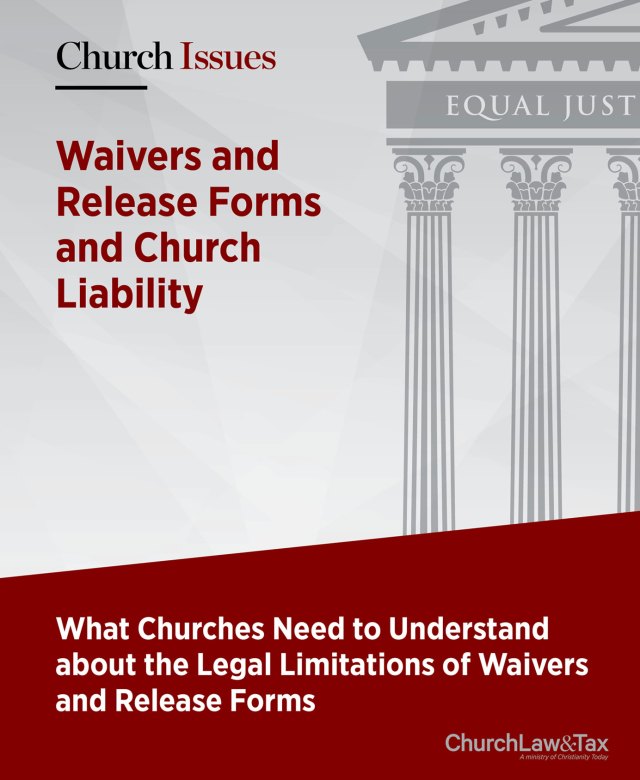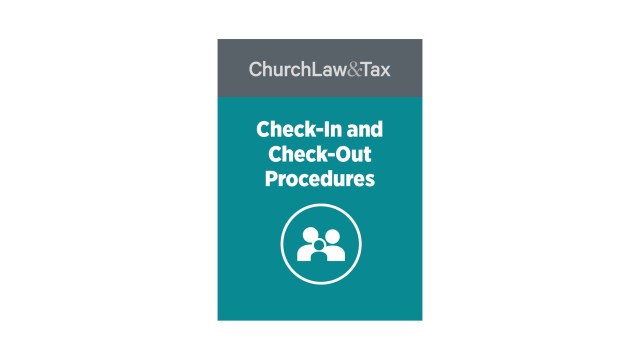Key point 10-16.6. A release form is a document signed by a competent adult that purports to relieve a church from liability for its own negligence. Such forms may be legally enforceable if they are clearly written and identify the conduct that is being released. However, the courts look with disfavor on release forms, and this has led to several limitations, including the following: (1) release forms will be strictly and narrowly construed against the church; (2) release forms cannot relieve a church of liability for injuries to minors, since minors have no legal capacity to sign such forms and their parents' signature does not prevent minors from bringing their own personal injury claim after they reach age 18; (3) some courts refuse to enforce any release form that attempts to avoid liability for personal injuries on the ground that such forms violate public policy; and (4) release forms will not be enforced unless they clearly communicate that they are releasing the church from liability for its negligence.
A federal district court in Minnesota ruled that the mother of a college student who was killed while participating in an "outdoor leadership school" in India was barred from suing the school because of a release form that her son had signed as part of the registration process. The National Outdoor Leadership School (NOLS) is a Wyoming corporation that organizes remote wilderness expeditions for students. In 2011, an adult male (the "victim") enrolled in a NOLS course in India. At the time he enrolled in the course, the victim signed a document (the Agreement) titled "NOLS Student Agreement (Including Assumption of Risks and Agreements of Release and Indemnity)." The agreement referred to several other documents and stated that the vicitm "has read and understands the general information about NOLS and its courses … including NOLS' Admission Policies, the statement titled Risk Management at NOLS, the NOLS Enrollment Packet and other material provided by NOLS describing or related to the program." The agreement also contained a clause providing that "any dispute between [the victim] and NOLS will be governed by the laws … of the State of Wyoming, and any mediation or suit shall occur or be filed only in the State of Wyoming." The victim further agreed that the terms of the agreement would "be binding upon him, his heirs, estate, executors and administrators."
A few weeks after signing the agreement, the victim began a 30-day hike near the Gori Ganga River in India, accompanied by other students and NOLS staff. Heavy rain caused the deterioration of trail conditions. During the hike, the victim fell down a steep incline and is presumed dead.
The victim's mother sued NOLS, claiming that the release provision in the agreement was invalid and unenforceable, and that NOLS was responsible for her son's death on the basis of negligence.
validity of the agreement
The mother argued that the agreement was invalid for lack of independent consideration. The court noted that "formation of a contract requires a specific and definite offer, acceptance, and consideration," and "consideration may consist of either a benefit accruing to a party or a detriment suffered by another party." Further, "it is well-established that a contract may consist of more than one document." The court, in concluding that the agreement was a valid contract, observed: "Here, the Agreement included [the victim's] representation that he 'read and understood … NOLS' Admission Policies, the statement titled Risk Management, the NOLS Enrollment Packet and other material provided by NOLS,' rendering those documents part of the Agreement.'
In concluding that the agreement was supported by valid consideration, the court noted that the victim "received several benefits from the Agreement in the form of college credit and participation in the program. In return, his father paid tuition and other expenses charged by NOLS. Such benefits and detriments constitute valid consideration for the Agreement."
applicability of the release provision to the victim's mother
The mother claimed that she was not a party to the agreement, and therefore the release provision did not apply to her. The court disagreed, noting that "it is well-established that a decedent may bind his heirs by contract," and "indeed, the plain language of the Agreement indicates that it was intended to bind the victim's heirs."
contract of adhesion
The mother claimed that the agreement was invalid because it was a "contract of adhesion."
Specifically, she argued that NOLS presented the agreement on a take-it-or-leave-it basis and that the victim's signature was the result of unequal bargaining power. The court noted:
Adhesion contracts are imposed on the public for a necessary service on a "take it or leave it" basis. Even though a contract is on a printed form and offered on a "take it or leave it" basis, those facts alone do not cause it to be an adhesion contract. There must be a showing that the parties were greatly disparate in bargaining power, that there was no opportunity for negotiation and that the services could not be obtained elsewhere. Here, the mother argues that her son was a college student and that NOLS is a corporation with substantial resources and comparatively greater sophistication. She does not, however, allege that there was fraud or coercion, that her son unsuccessfully sought to negotiate the clause or that NOLS insisted upon its inclusion. Indeed, NOLS states that in response to previous requests by participants, it had negotiated and in many instances agreed to change the terms of an agreement… . Further [the victim] was in no way obligated to enroll in the NOLS course or agree to the terms of the Agreement, and his mother has not argued that he could not have obtained the services offered by NOLS elsewhere. Nor does she argue that NOLS provided a necessary service. As a result, the [Agreement] is not a contract of adhesion.
What This Means For Churches:
A release form is a document signed by a competent adult that purports to relieve a church from liability for its negligence. The courts look with disfavor on release forms, and this has led to several limitations, including the following:
(1) Release forms will be strictly and narrowly construed against the church.
(2) Release forms will not be enforced if they are ambiguous.
(3) Release forms cannot relieve a church of liability for injuries to minors, since minors have no legal capacity to sign such forms and their parents' signature does not prevent minors from bringing their own personal injury claim after they reach age 18.
(4) Some courts refuse to enforce any release form that attempts to avoid liability for personal injuries on the ground that such forms violate public policy.
(5) Some courts refuse to enforce release forms that attempt to avoid liability for intentional acts, gross negligence, or willful or wanton conduct. If a release form does not explicitly exclude such conduct from its terms, the form may be invalidated by a court.
(6) Release forms will not be enforced unless they clearly communicate that they are releasing the church from liability for its negligence.
(7) Some courts refuse to enforce release forms if they are "contracts of adhesion" based on a gross disparity in bargaining power between the releasor and releasee. To illustrate, if the person signing a release form has no ability to change it, this may suggest an unenforceable adhesion contract. On the other hand, some courts have ruled that a release form is not an unenforceable contract of adhesion if the party signing the form could walk away from the transaction and do business elsewhere. This exception may or may not apply to a church, depending on the circumstances. After all, is it realistic to say that a church member has the right to walk away and attend another church, and therefore a release form is not a contract of adhesion?
(8) Some courts refuse to enforce a release form that is inconspicuous. To illustrate, if the language of release is buried in another, larger document, without a bold heading and other devices to draw attention to it, it may be unenforceable.
(9) Some courts have ruled that release forms that do not contain a signature by the releasor are unenforceable. To illustrate, if the language of release is contained in a larger document, a signature line should appear directly after the language of release as well as at the end of the document.
Churches should not use releases without discussing them with their insurance agent and an attorney. Brenner v. National Outdoor Leadership School, 2014 WL 2069364 (D.Minn. 2014)
Tip. Churches that send groups of adults to other locations for short-term missions projects should consider having each participating adult sign an assumption of risk form. So long as these forms clearly explain the risks involved, and leave no doubt that the signer is assuming all risks associated with the trip, they may be enforced by the courts. This assumes that the signer is a competent adult. Churches should consult with an attorney about the validity of such forms under state law.
Parental Permission and Medical Consent Forms
Churches should not allow a minor child to participate in any church activity (such as camping, boating, swimming, hiking, or some sporting events) unless the child's parents or legal guardians sign a form that (1) consents to their child participating in the specified activity; (2) certifies that the child is able to participate in the event (e.g., if the activity involves boating or swimming, the parents or guardians should certify that the child is able to swim); (3) lists any allergies or medical conditions that may be relevant to a physician in the event of an emergency; (4) lists any activities that the parents or guardians do not want the child to engage in; and (5) authorizes a designated individual to make emergency medical decisions for their child in the event that they cannot be reached.
Ideally, the form should be signed by both parents or guardians (if there are two), and the signatures should be notarized. If only one parent or guardian signs, or the signatures are not notarized, the legal effectiveness of the form is diminished. Having persons sign as witnesses to a parent's signature is not as good as a notary's acknowledgment, but it is better than a signature without a witness. The form should require the parent or guardian to inform the church immediately of any change in the information presented, and it should state that it is valid until revoked by the person who signed it. The parent or guardian should sign both in his or her own capacity as parent or guardian, and in a representative capacity on behalf of the minor child.

